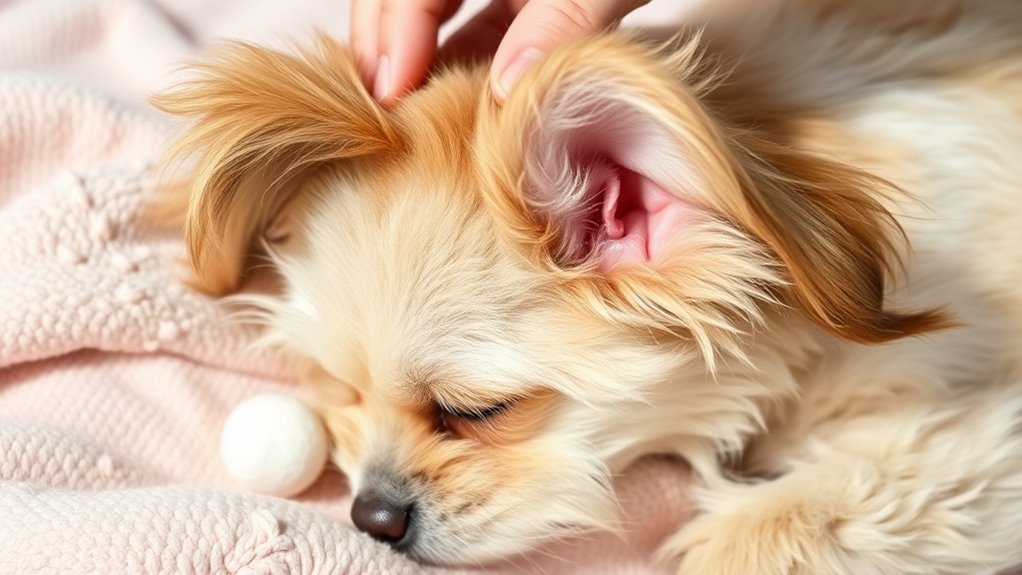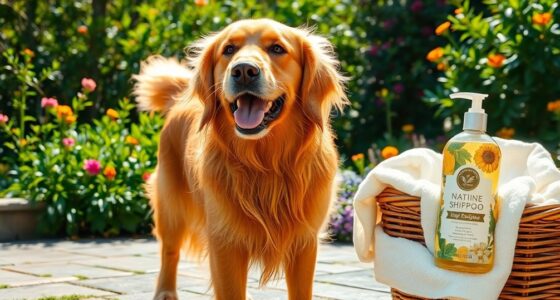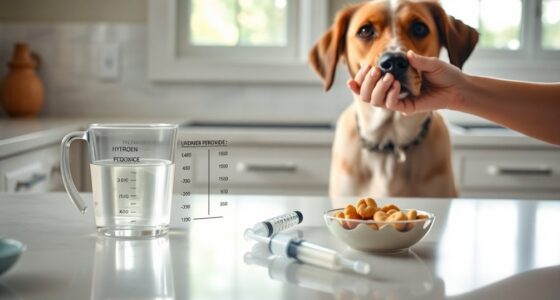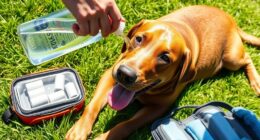To prevent ear infections in floppy-eared breeds, regularly inspect and gently clean their ears with vet-approved products, making sure to dry them thoroughly after baths or swimming. Maintain a clean environment, avoid outdoor muddy areas, and promote good nutrition with omega-3s and vitamins to support ear health. Keep an eye out for signs of discomfort and seek veterinary advice when needed; more tips help keep their ears healthy and infection-free.
Key Takeaways
- Regularly inspect and clean floppy ears to remove dirt, wax, and excess moisture.
- Use veterinarian-approved ear cleaning solutions and avoid inserting objects deep into the ear canal.
- Keep ears dry after baths or swimming by gently drying with towels or drying solutions.
- Schedule routine veterinary checkups for early detection and breed-specific ear health advice.
- Minimize outdoor exposure in muddy or rainy conditions to prevent dirt and moisture buildup.
Understanding Why Floppy Ears Are Prone to Infections
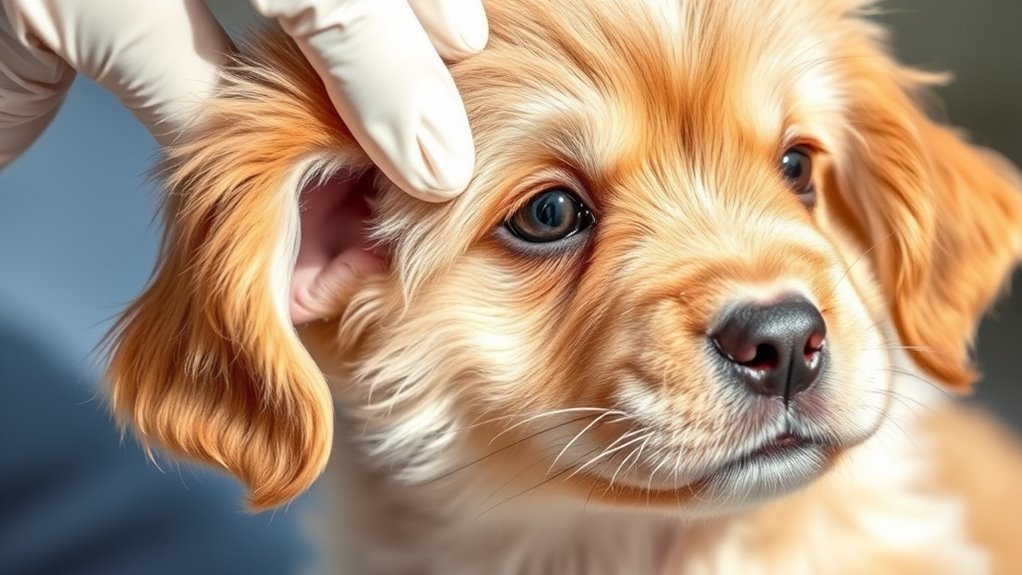
Floppy ears are more susceptible to infections mainly because their shape creates a warm, moist environment that fosters bacterial and yeast growth. The ear canal structure in these breeds often traps moisture and debris, making it harder for the ear to dry out naturally. Additionally, their ear skin sensitivity means the skin is more prone to irritation and inflammation when exposed to moisture or irritants. The lack of proper airflow within the floppy ear flap reduces ventilation, further increasing the risk of infection. Because their ears tend to stay damp longer, bacteria and fungi thrive, leading to common ear infections. Understanding this connection between ear canal structure and skin sensitivity helps you recognize why floppy ears require extra attention and care. Proper ear hygiene is essential in preventing infections and maintaining overall ear health.
Regular Ear Inspections and Monitoring
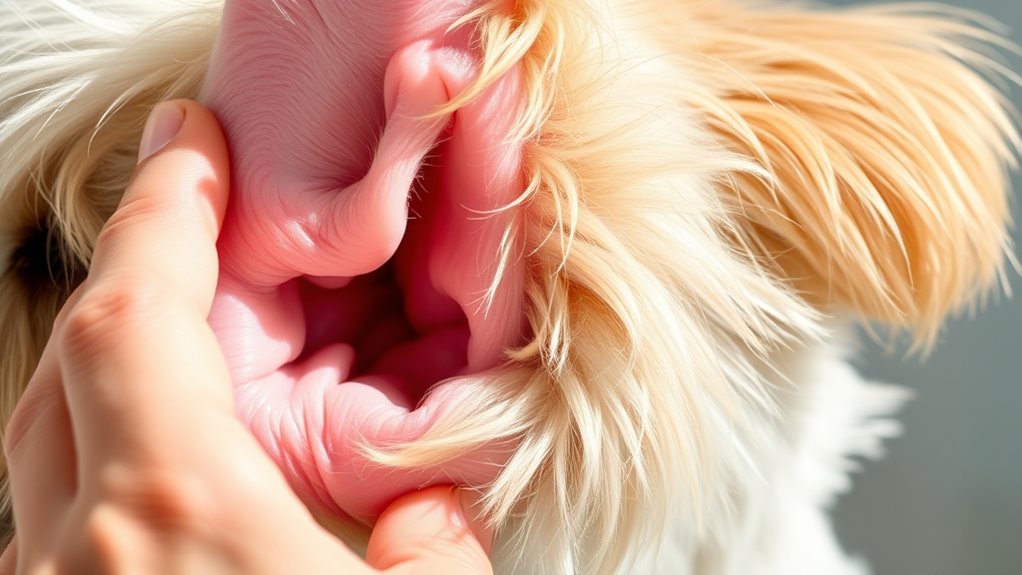
Since infections develop quickly in floppy ears, regular inspections are essential to catch problems early. You should check your dog’s ears weekly for signs of redness, swelling, or unusual odor. Many ear infection myths suggest only visible discomfort warrants attention, but subtle changes can indicate brewing issues, especially given breed-specific risks. Breeds like Cocker Spaniels or Basset Hounds are more prone to infections due to their ear structure. Monitoring your dog’s ears helps prevent minor irritations from becoming serious infections. Don’t rely on assumptions or myths—consistent inspections provide peace of mind and early detection. If you notice any abnormalities, consult your veterinarian promptly. Regular monitoring is a simple yet vital step in keeping your floppy-eared companion healthy and comfortable.
Proper Ear Cleaning Techniques for Sensitive Breeds
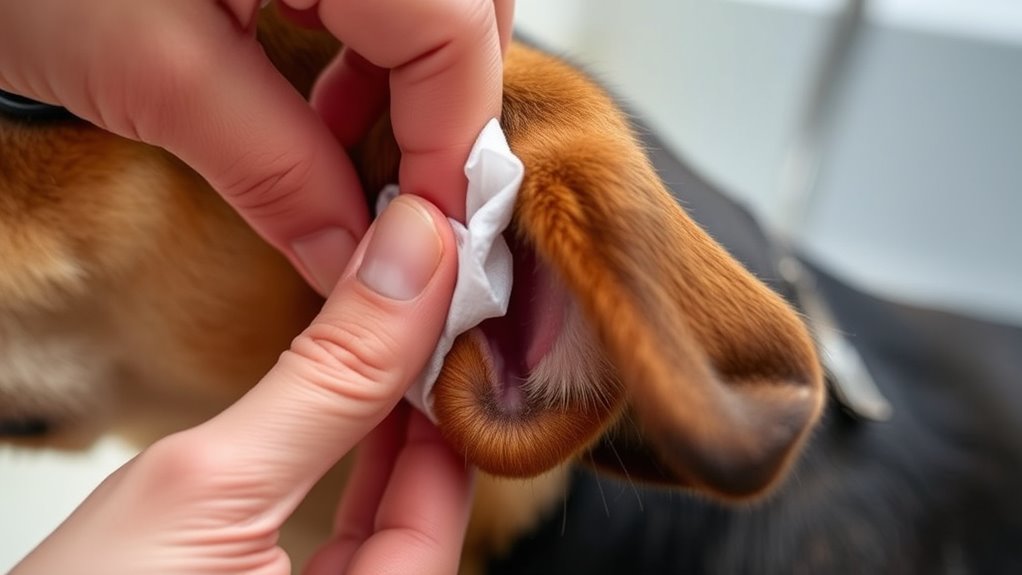
When cleaning your dog’s ears, use gentle techniques to avoid causing irritation or discomfort. Choose appropriate ear cleaning products that are safe for sensitive breeds, and establish a regular maintenance schedule to keep ears healthy. Consistent care helps prevent infections and keeps your dog comfortable. Incorporating proper ear cleaning techniques can further enhance ear health and reduce the risk of infections.
Gentle Cleaning Methods
Gentle ear cleaning is essential for sensitive breeds to prevent infections without causing discomfort or damage. To safely perform earwax removal and spot ear infection symptoms, follow these steps:
- Use a soft, damp cloth or specialized gentle wipe designed for sensitive ears.
- Avoid inserting objects deep into the ear canal; instead, gently wipe the outer ear.
- Apply a veterinarian-approved ear cleaner if necessary, following instructions carefully.
- Observe your dog for signs of discomfort or redness during cleaning.
- Recognize that regular, gentle cleaning can also help monitor ear health and prevent potential issues. Proper technique helps prevent irritation and keeps ears dry, reducing the risk of infections. Regular, gentle cleaning supports ear health and early detection of ear infection symptoms, especially in breeds with sensitive ears.
Appropriate Ear Products
Choosing the right ear products can make a significant difference in maintaining your dog’s ear health. For sensitive breeds, select gentle, vet-approved ear cleaners that support ear hygiene without causing irritation. Avoid harsh chemicals or alcohol-based solutions, as these can worsen inflammation or damage delicate skin. Proper ear products help remove debris and excess moisture, reducing the risk of infections. If your dog shows signs of discomfort or has a history of ear issues, consider ear infection remedies recommended by your veterinarian. Always use products specifically formulated for dogs and follow the instructions carefully. Regular use of appropriate ear products promotes healthy ears, prevents infections, and keeps your floppy-eared companion comfortable and happy. Glycolic acid is known to support skin health and maintain a clean, irritation-free environment. Additionally, adopting a preventive approach by incorporating regular ear inspections can help catch issues early before they develop into infections. Incorporating AI-driven tools for monitoring your pet’s ear health can further enhance early detection and intervention. Being aware of ear cleaning techniques can also reduce the risk of injury during maintenance.
Regular Maintenance Schedule
How often should you clean your dog’s ears to prevent infections? For floppy-eared breeds, a regular maintenance schedule is essential. Many ear health myths suggest infrequent cleaning, but breed-specific issues demand consistent care. Here’s a simple routine:
- Weekly Checks: Examine ears for dirt, redness, or odor.
- Bi-weekly Cleaning: Use veterinarian-approved solutions to gently clean ears.
- Monitor for Signs: Watch for scratching, head shaking, or foul smell.
- Adjust Frequency: Increase cleaning if your dog has allergies or tends to get infections.
- Maintain Proper Ear Hygiene: Incorporating natural materials such as linen or wood in your cleaning tools can help reduce irritation. Additionally, choosing appropriate cleaning products designed for sensitive skin can further prevent issues. Recognizing breed-specific vulnerabilities can help tailor your cleaning routine effectively. Regular maintenance also helps prevent the buildup of wax and debris, which is especially important for breeds with ear canal structure that predisposes them to infections.
Sticking to a routine helps prevent the buildup of wax and debris, addressing breed-specific issues before they escalate. Regular maintenance dispels myths about over-cleaning and keeps your dog’s ears healthy and infection-free.
Choosing Safe and Effective Ear Cleaning Products

Selecting the right ear cleaning products is essential for preventing infections in floppy-eared breeds, as some solutions can cause irritation or damage if not chosen carefully. You should look for products specifically formulated for dogs, avoiding harsh chemicals that can worsen ear infection symptoms or compromise ear cleaning safety. Always read labels and choose gentle, pH-balanced cleansers designed to remove dirt and excess moisture without irritating sensitive skin. pH-balanced cleansers are particularly beneficial in maintaining the natural acidity of your dog’s ear environment, reducing the risk of infection. Properly selected ear cleaners help maintain ear health, reduce the risk of buildup, and prevent infections. Using appropriate cleaning tools can further enhance the safety and effectiveness of ear care routines. Additionally, understanding ear anatomy can help you perform more effective and safe cleaning procedures. Maintaining a good understanding of ear health can support early detection and prevention of issues before they become serious. Remember, if your dog shows signs of discomfort or persistent ear infection symptoms, stop using the product and seek professional advice.
How to Dry Ears Thoroughly After Baths or Swimming

After baths or swimming, gently pat your dog’s ears dry with a soft towel to make certain excess moisture is removed. You can also use ear drying solutions to help evaporate remaining water and prevent infections. Keep their ears upright during drying to ensure thorough moisture removal and airflow. Regularly checking and maintaining ear cleanliness can further reduce the risk of ear infections. Additionally, ensuring proper ear hygiene can significantly lower the likelihood of developing issues related to moisture buildup.
Use Gentle Towels
Using gentle towels is essential for thoroughly drying your dog’s ears after baths or swimming. Soft cloths or gentle towels help prevent irritation and reduce moisture buildup that can cause infections. To guarantee proper drying, follow these steps:
- Use a soft cloth or towel to gently pat the ears, avoiding vigorous rubbing.
- Focus on the ear canal opening and surrounding folds to remove excess water.
- Tilt the head slightly to help water drain out naturally.
- Keep the ears dry and open for a few minutes, allowing any remaining moisture to evaporate.
- Regularly inspecting and maintaining ear hygiene helps prevent ear infections in floppy-eared breeds.
- Incorporating proper drying techniques can significantly reduce the risk of moisture-related issues.
- Being aware of affairs and infidelity exposure can help pet owners stay informed about common online scams that may target pet owners seeking advice.
- Ensuring good ventilation and airflow around the ears can further help keep them dry and healthy.
Use Ear Drying Solutions
To guarantee your dog’s ears dry completely after baths or swimming, applying ear drying solutions can be highly effective. These solutions help remove moisture from floppy ears, reducing the risk of infections. Use a few drops of ear drying solution into each ear, then gently massage the base to distribute it evenly. Let your dog shake their head naturally to loosen excess moisture. For added clarity, here’s a helpful comparison:
| Benefit | How It Works | Tips |
|---|---|---|
| Removes moisture | Evaporates trapped water in ear canal | Use after every bath or swim |
| Prevents infections | Keeps ears dry and reduces bacteria growth | Avoid overusing to prevent irritation |
| Easy to use | Simple drops and gentle massage | Always follow product instructions |
Using ear drying solutions is a simple step to keep floppy ears healthy and infection-free. Additionally, choosing appropriate ear cleaning methods can further enhance ear health and prevent issues. Incorporating proper ear hygiene routines is essential for maintaining optimal ear health in floppy-eared breeds.
Keep Ears Upright
Keeping your dog’s ears upright during drying is essential to guarantee they dry thoroughly and prevent moisture buildup. Proper ear flap hygiene reduces the risk of infections, especially in floppy-eared breeds. Use effective ear positioning techniques to ensure air reaches all parts of the ear canal. Here are some tips:
- Gently hold the ear flap upright with your hand or a soft cloth.
- Use a towel or ear dryer to blow warm air into the ear, avoiding direct contact.
- Keep the ears in an upright position for several minutes to promote drying.
- Check regularly to ensure no moisture remains, especially around the base of the ear.
- Incorporating air circulation techniques, such as gentle fan use, can further enhance thorough drying and reduce moisture retention.
Maintaining this position helps air circulate and prevents trapped moisture, reducing infection risks.
Recognizing Early Signs of Ear Problems
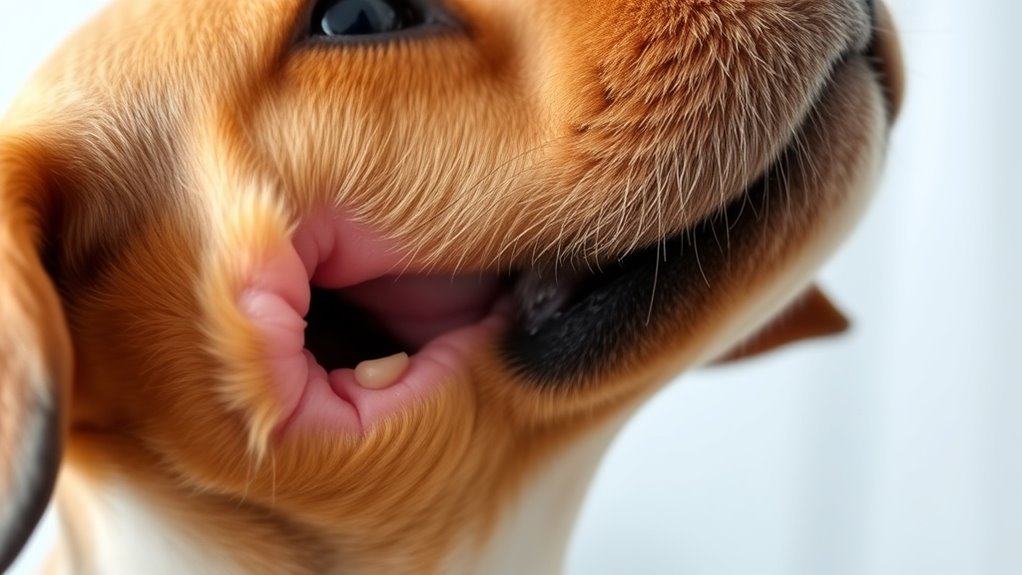
Early detection of ear problems is key to preventing infections in floppy-eared breeds. Being alert to ear infection symptoms helps you catch issues before they worsen. Look for signs like frequent scratching, head shaking, or tilting. Notice if your dog has a foul odor or redness inside the ear canal. Excessive ear discharge or swelling are also warning signs. Using early detection methods, such as regular visual checks and gentle palpation, allows you to spot problems early. If you observe any of these symptoms, consult your vet promptly. Recognizing these signs quickly can prevent painful infections and reduce the need for extensive treatments. Incorporating simple preparation methods can make routine ear checks more manageable for busy pet owners. Staying attentive to your dog’s ear health is essential for maintaining their comfort and preventing serious issues down the line.
Maintaining a Clean Living Environment to Minimize Dirt and Debris
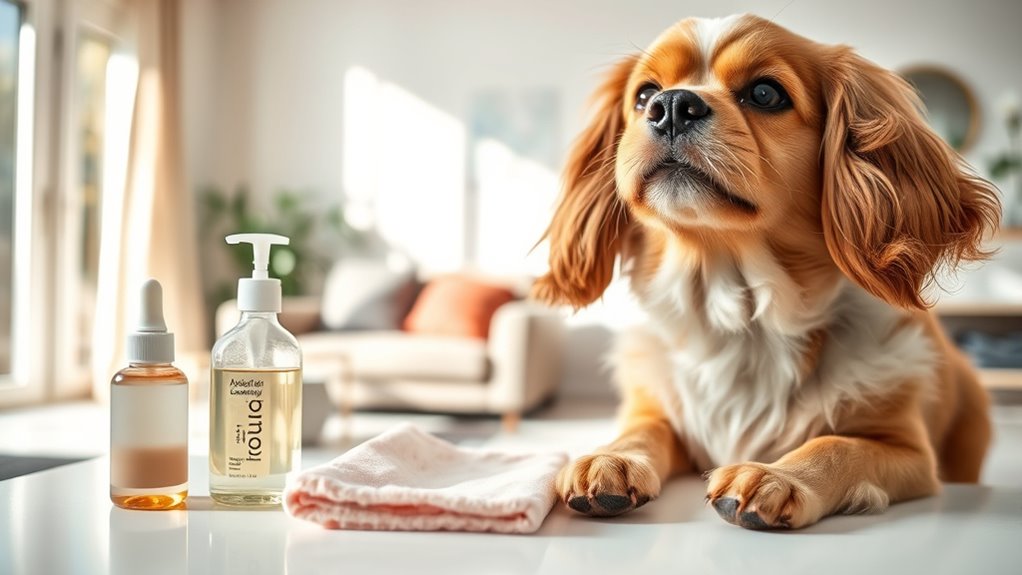
A clean living environment plays a essential role in preventing ear infections in floppy-eared breeds. Keeping your pet’s space free of dirt and debris reduces bacteria and mold buildup that can cause infections. Focus on these key areas:
- Regularly change bedding hygiene to prevent dust and moisture accumulation.
- Clean and dry your pet’s bedding and living area weekly.
- After outdoor activity, wipe down their ears and check for dirt or debris.
- Limit outdoor exposure during muddy or rainy conditions to avoid dirt getting into their ears.
Maintaining a tidy environment minimizes the risk of irritants reaching their ears. Ensuring cleanliness and monitoring outdoor activity are simple yet effective steps to support ear health and prevent infections.
Dietary Considerations for Ear Health

Feeding your dog nutrient-rich foods helps support healthy ear tissues and boosts their immune system. You should also watch out for potential allergens in their diet, as these can trigger inflammation and increase infection risk. By choosing the right foods, you can give your floppy-eared breed a better chance at maintaining ear health.
Nutrient-Rich Foods
Incorporating nutrient-rich foods into your floppy-eared pet’s diet can markedly support ear health and reduce the risk of infections. Understanding ear infection causes and breed-specific risks helps you choose the right nutrients. Consider including:
- Omega-3 fatty acids from fish oil to reduce inflammation and promote a healthy immune response.
- Probiotics to support gut health, which is linked to immune function and may prevent infections.
- Vitamin E-rich foods like spinach and carrots to help repair tissue and strengthen ear skin.
- Zinc sources such as lean meats and legumes to enhance healing and combat bacteria that cause infections.
These nutrients address core ear infection causes and breed-specific risks, helping keep your pet’s ears healthier and less prone to recurring issues.
Avoid Allergens
Since allergens in your pet’s diet can trigger or worsen ear infections, it’s vital to identify and avoid ingredients that may cause sensitivities. Conduct allergy testing to pinpoint specific food or environmental allergens contributing to ear issues. Once identified, eliminate these ingredients from your pet’s diet to reduce inflammation and irritation. Additionally, practicing environmental control—such as keeping your home clean, reducing exposure to pollen, dust, and mold—helps minimize allergen intake. Reading labels carefully and choosing hypoallergenic or limited-ingredient foods can make a significant difference. Regularly monitoring your pet’s response to dietary changes ensures you’re reducing potential triggers. By combining allergy testing with vigilant environmental control, you can help prevent recurring ear infections and promote healthier ears for your floppy-eared breed.
When to Seek Veterinary Assistance
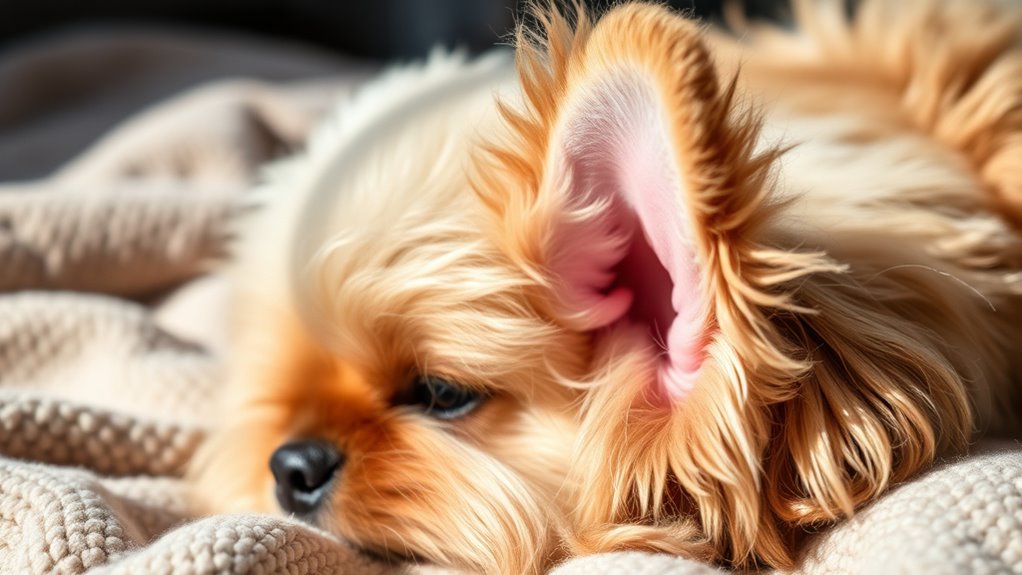
You should seek veterinary assistance promptly if you notice persistent redness, swelling, or foul odor in your dog’s ears, as these can indicate an infection that requires professional treatment. Recognizing ear infection symptoms early is essential for effective care. Veterinary consultation triggers include:
- Continuous scratching or pawing at ears
- Discharge or unusual debris in the ear canal
- Excessive head shaking or tilting
- Visible inflammation or foul smell
If you observe any of these signs, don’t delay. Prompt veterinary attention helps prevent the infection from worsening or causing long-term damage. Early intervention ensures your dog’s comfort and health. Remember, timely vet visits are critical when ear infection symptoms persist or escalate.
Tips for Long-Term Ear Care and Prevention Strategies

Regular ear cleaning and routine inspections are essential to prevent infections and maintain your dog’s ear health over the long term. Many ear infection myths suggest that frequent cleaning harms your dog, but breed-specific care proves otherwise. Proper care reduces moisture and debris buildup, especially in floppy-eared breeds prone to infections. To stay proactive, create a care routine tailored to your dog’s needs, considering their breed characteristics. Remember, consistent checks help catch issues early.
| Long-Term Care Tip | Why It Matters | What You Can Do |
|---|---|---|
| Clean ears regularly | Prevents bacteria buildup | Use vet-approved solutions |
| Monitor for signs | Detects infections early | Check ears weekly |
| Educate yourself on breed care | Overcomes ear infection myths | Follow breed-specific tips |
Frequently Asked Questions
Are There Specific Breeds More Prone to Ear Infections Than Others?
Certain breeds are more prone to ear infections due to breed susceptibility and genetic predisposition. You should be aware that dogs with floppy ears, such as Cocker Spaniels and Basset Hounds, often have reduced airflow and moisture buildup, increasing infection risk. Regular cleaning and inspections are essential for these breeds. Understanding their genetic predisposition helps you take proactive steps to keep their ears healthy and prevent infections.
Can Home Remedies Effectively Prevent Ear Infections in Floppy-Eared Dogs?
You might wonder if home remedies can prevent ear infections, and the answer is yes, to some extent. Natural remedies like gentle cleaning with a vet-approved solution can help keep ears dry and reduce bacteria. Incorporate preventive measures such as regular inspections and keeping ears dry after baths or swimming. However, always consult your vet before trying home remedies, as they’re most effective when combined with professional advice.
How Often Should Professional Veterinary Ear Cleanings Be Performed?
When it comes to professional cleaning frequency, it’s best not to put all your eggs in one basket. According to veterinary recommendations, you should have your dog’s ears professionally cleaned every 6 to 12 months, depending on their breed and ear health. Regular check-ups help catch issues early, preventing infections. Keep in mind, your vet’s advice is the best guide to keep those floppy ears healthy and happy.
Do Certain Environmental Factors Increase the Risk of Ear Infections?
Environmental factors definitely increase your pet’s risk of ear infections. Moisture exposure from baths, swimming, or rain creates a damp environment that promotes bacteria growth. Allergy triggers like pollen, dust, or mold can cause inflammation and excess wax buildup. To reduce the risk, keep their ears dry, minimize exposure to potential allergens, and regularly check for signs of irritation. Being proactive helps prevent infections before they start.
Are There Any Signs That Indicate Chronic or Recurring Ear Issues?
Think of your dog’s ears as a garden that needs regular tending. If you notice persistent symptoms like redness, foul odor, excessive scratching, or swelling, these signals suggest chronic or recurring issues. Monitoring symptoms closely helps catch infections early and prevents recurrence. If these signs linger or worsen, it’s time to visit your vet. Staying vigilant guarantees your furry friend’s ears stay healthy and infection-free, just like a well-tended garden blooms.
Conclusion
By keeping a close eye on your floppy-eared friend, you can create a gentle shield against infections. Picture their ears as delicate petals, easily shaded by dirt and moisture if neglected. Regular inspections, proper cleaning, and a clean environment act as your protective hands. With attentive care, you’ll nurture healthy ears that stay happy and infection-free, allowing your dog to enjoy playtime in the sunshine and wagging tails without a worry in the world.

